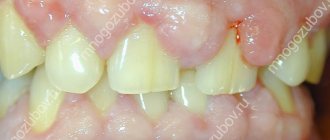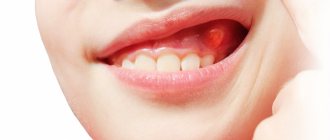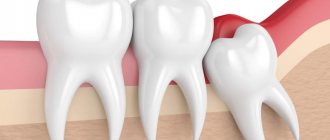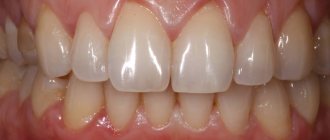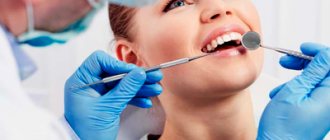Gingivitis, an inflammatory disease of the gums, is one of the most common dental diseases in young children. The main provocateur of the pathological process is the microbial flora of dental plaque. When the first signs of the disease are detected, the child should be shown to an experienced dentist.
In this article we will look at the symptoms of gingivitis in children, treatment
inflammatory gum disease in children of the first years of life, methods of prevention.
Causes of gum inflammation in children
First of all, gingivitis appears as a consequence of improper or insufficient oral hygiene. This problem can appear even in very young children who have only a couple of incisors in their mouth.
Many parents find the very idea of brushing a barely erupted tooth stupid, so the purchase of a brush is put off for an indefinite period. At the same time, the baby begins to receive the first complementary foods, which means an excellent field for the reproduction of a wide variety of bacteria is provided.
The symptoms of the inflammatory process are not much different from teething. The mucous membrane also swells, turns red and actively itches, so it is easier for mom and dad to attribute the vagaries to the appearance of neighboring teeth than to think about the onset of the disease.
On the other hand, just at the moment of intensive cleaning, a delicate area can be damaged. It only takes the wrong choice of toothbrush or floss to cause physical damage that can easily attract bacteria.
Gum diseases in children: what causes pain
The most common cause of pain in babies is the eruption of new teeth. But if the problem is caused by poor hygiene, then pretty soon the inflammation will become just one of many symptoms that the doctor will have to treat. Making a diagnosis in most cases is not difficult. It is enough for a specialist to take a quick look at the oral cavity to understand what kind of pathological process has been launched.
Stomatitis
If the gums are swollen and painful in a child of the first or second year of life, the most likely disease will be this lesion of the mucous membrane. Most often it is infectious or viral in nature, for example, caused by the herpes virus. In addition to the membrane covering the alveolar part of the upper and lower teeth, the disease often affects the inside of the lips and cheeks.
Externally, the problem manifests itself as small white bubbles, which are painful and prevent the baby from eating normally. An increase in body temperature is also very likely, which is why parents often define the child’s condition as a banal ARVI and do not take proper measures to eliminate the cause of the discomfort.
Stomatitis requires mandatory seeking medical dental care. Antiviral and sometimes antibacterial drugs are prescribed for treatment, and given the early age of the patient, their dosage is extremely important. If the disease is left to chance, it will spread far beyond the oral area, affecting the internal organs.
Acute catarrhal gingivitis
In this case, we are talking about an inflammatory process caused by the formation of a microbial plaque on the mucous membrane. Usually it does not exist on its own, but as a consequence of another infectious disease, for example, chickenpox. It is because of this problem that a 4-5 year old child can often have sore gums.
Why is this happening? Mainly because the immune system had already devoted all its strength to treating the more severe and dangerous chickenpox, it was greatly weakened and allowed the bacteria that had entered the body to pass through. They can get into the oral cavity in different ways, but most often the culprit is poorly washed hands before eating and poor dental hygiene. Among the symptoms of the disease, the most unpleasant are:
- Painful sensations when eating and drinking.
- Bleeding (often not in one specific place, but throughout the entire mucous membrane).
- Swelling.
- Increased plaque deposits between teeth and gums and, as a result, an unpleasant odor.
As in the case of stomatitis, in case of acute manifestation of the disease, it is necessary to consult a dentist. The patient undergoes complex antiviral and antibacterial therapy with complete sanitation. If the problem is ignored, the tissues that hold the teeth will be greatly weakened, which means there is a high risk of losing them, not only milk ones, but also permanent ones in the future.
Purulent gingivitis
This form of the disease is somewhat less common than catarrhal disease, mainly as a complication. In this case, a particularly putrid odor is added to the symptoms listed above, the color of the mucous membrane approaches bluish, and when pressure is applied to it, in addition to blood, pus is released. If a child’s gums are inflamed and severely painful due to this disease, contacting the dentist cannot be put off for a single day. Immediate medical intervention is required, often surgical.
Treatment includes septic treatment of the oral cavity, as well as anti-inflammatory drugs and antibiotics. Given the patient's early age, it is important to accurately calculate the dosage and carry out the full course of therapy, even if the symptoms have significantly weakened or completely disappeared. Otherwise, the disease will almost certainly become chronic or periodontitis, which carries with it even more dangerous consequences.
Caries
There is an opinion that this problem leads directly to toothache, but in fact, if a child has pain in the upper or lower gums, this may be a consequence of the destruction of that part of the tooth that is in direct contact with the mucous membrane. The fact is that the milk range, in principle, is not particularly strong; the enamel is quite thin and quickly becomes covered with plaque or stone. Why is this not noticeable to parents? Yes, simply because damage may begin from a poorly visible part. For the same reason, insufficient hygienic treatment is carried out here.
Accompanied by caries and another nuisance, mainly psychological. Remembering their unpleasant and even painful sensations during caries treatment, mothers and fathers simply refuse to take their baby to the doctor, because sooner or later the primary incisors and canines will change, and the problem will be solved by itself. This is wrong. The place for the growth of the permanent incisor and canine will be greatly damaged, which means it will become much more difficult to keep them in place. Therefore, if a child has pain in the gum above the tooth, it is worth going to an appointment and making sure that the localization of the disease is correctly determined.
Periodontitis
As mentioned earlier, most often it is a consequence of gingivitis that was not treated in early childhood and preschool age. Literally everything matters for its development:
- Features of oral hygiene.
- Hormonal background.
- Disturbances in the functioning of the immune system.
- Taking any medications.
- Unbalanced nutrition and, as a result, insufficient amounts of vitamins and minerals in the body, and much more.
The problem becomes obvious during the change of baby teeth to permanent ones, and therefore the disease is typical for younger schoolchildren. If the gums of a 6, 7, 8 year old child hurt, the likelihood that it was caused by periodontitis is very high.
In addition to the obvious inflammatory process and bleeding, the disease is manifested by excessive tooth mobility and changes in the color of the mucous membrane. Sometimes the temperature rises, general weakness and fatigue appear. Treatment is prescribed depending on the extent to which the lesion has developed. Usually, a complete sanitation of the oral cavity is carried out, antibiotics and other drugs are prescribed. Sometimes the use of braces is required.
What types of gingivitis occur in children?
- Most often, catarrhal gingivitis occurs with a burn or accidental mechanical injury to the mucous membrane. It is manifested by swelling of the periodontal tissues and pain when pressing on the gums, often becomes chronic and over time can develop into inflammation of the periodontal tissues - periodontitis.
- With hypertrophic gingivitis, the mucous membrane swells, becomes purple-blue and enlarges, “creeping” over the teeth. Pus is released from the formed periodontal pocket.
- In the atrophic form, the gums, on the contrary, turn pale and recede, exposing the tooth root.
- If left untreated, catarrhal gingivitis may not become chronic, but develop into an ulcerative form. The appearance of bleeding ulcers is accompanied by severe pain and a significant increase in temperature.
Associated symptoms
If a child’s gums are swollen and painful, and a baby tooth can already be clearly felt through it, parents can help the child cope with the pain by rubbing in anesthetic ointments. But teething is often a protracted process, so the pathology can torment children at different intervals without obvious signs such as redness or inflammation. Even in this case, you can understand the reason for the baby’s bad mood by additional signs:
- Changes in appetite (usually to a lesser extent, since chewing food becomes painful).
- Poor shallow sleep.
- Irritability and moodiness.
- Increased attention to the pacifier (the baby either throws it away or asks for it again).
If a child 3 years of age or older has gum pain, he will be able to tell about it himself, but a smaller child will have to be monitored much more closely.
If your temperature rises
This reaction occurs for almost any reason for inflammation of the mucous membrane, be it infection, periodontitis or simple teething. But depending on which pathogen was the culprit, the increase varies from 37.5 to 39 degrees. The further actions of parents depend on this indicator.
As long as he stays within subfebrile limits, it is enough to give him as much fluid as possible. If a child’s gums hurt and the temperature exceeds 38.5 degrees, you should give him paracetamol in a convenient form and dosage indicated by age.
Remember that even when the fever goes down quickly and does not rise again, you still need to consult a doctor to make an accurate diagnosis. Delaying this moment for an indefinite period can lead to unpleasant consequences.
Possible complications
The most common difficulty caused by absent or poor-quality treatment of inflammation of the jaw mucosa is considered to be chronicity. This means that whatever the true cause of the disease, it will become chronic and will recur with every decrease in immunity or stressful situation.
It is difficult to say how vivid the symptoms will remain and whether they will interfere with normal life. Every body is unique and deals with problems differently. In some cases, the disease goes away for years, in others it returns every month.
Another possible complication is a deterioration in the functioning of the immune system, especially the throat, larynx, nose, and ears. Untreated infections often lead to sinusitis, bronchitis, tracheitis and other diseases. With age, other internal organs are also affected.
Treatment methods
Some of the common childhood gum diseases include:
- stomatitis (inflammation of the mucous membrane due to a virus or fungus);
- periodontitis (advanced form of gingivitis);
- periodontal disease (associated with inflammation, rarely diagnosed);
- gingivitis (a consequence of injury or plaque, usually occurs in the catarrhal form, during the eruption or change of teeth).
For treatment, local administration of various medications and rinsing with antiseptics may be prescribed. Additional measures: sanitation of the oral cavity and removal of tartar. In the chronic form, physiotherapeutic methods are used.
How to treat a child’s gums: basic methods
The medical therapy used depends on the cause of the pain. In the case of banal teething and in the absence of associated complications, doctors make do with the prescription of light ointments and gels with an anesthetic effect. They can also teach parents about proper oral hygiene for their baby and tell them about possible negative consequences.
In cases where the problem lies deeper and is infectious in nature, anti-inflammatory and antibacterial agents are prescribed. the selection of medications is strictly individual; there is no universal solution.
If a 9-10 year old child has gum pain, surgical tooth extraction or professional sanitation is possible. Strictly speaking, this option is also applicable for the treatment of preschool children, but dental specialists try to carry out minimal intervention for early childhood, so as not to frighten the baby.
Remedies for inflammation of the mucous membrane
Let us immediately note that any medical drug, even the safest one, has significant contraindications, and therefore, before taking them, it would not be superfluous to consult with a dental doctor.
But if the question “what to do when a child has gum pain” is acute, and there is no opportunity to see a specialist in the near future, you can try to get by with the most common medications:
- For light pain relief and cooling during the teething period, use gels “Kalgel”, “Dentol”, “Cholisal”. They are suitable for the youngest patients and have a fast-acting effect.
- Chlorhexidine, Miramistin, and vitamin A in oily form are suitable for treating the oral cavity for stomatitis.
- When the temperature rises, it is recommended to give the baby an appropriate dose of ibuprofen for his age. It will not only relieve fever, but also relieve pain.
As soon as possible, immediately take your child to see a doctor to rule out complications.
Folk remedies for pain relief
The question of how to treat when children have sore gums is also familiar to those who are against the use of medications before being prescribed by a specialist. The following can be used as homeopathic and natural remedies:
- A solution of baking soda or slightly diluted potassium permanganate for antiseptic treatment.
- Infusion of chamomile and sage to reduce pain.
- Ice or chilled soft fruit to relieve swelling.
Such remedies will not produce the desired therapeutic effect, but will provide a restful sleep for the baby and parents, and will give them the opportunity to wait for their scheduled medical appointment.
Permanent teeth
Timing of teething in children
The first permanent teeth appear several months before the baby teeth fall out—the molars, or “sixes,” erupt. This occurs at the age of six. By the age of eight or nine years, it is the turn of the incisors. When a child is ten to twelve years old, premolars and canines erupt. Next come the second molars, the eruption of molars is completed by adulthood.
Important!
Wisdom teeth appear much later, after twenty years. However, their complete absence is also the norm.
Timing of teething in the table
| Name | Lower jaw - time of eruption | Upper jaw - eruption time |
| Medial incisor | 6 - 7 years | 7 - 8 years |
| Lateral incisor | 7 - 8 years | 8 - 9 years |
| Fang | 9 - 10 years | 11 - 12 years |
| First premolar | 10 - 12 years | 10 - 11 years |
| Second premolar | 11 - 12 years | 11 - 12 years |
| First molar | 6 - 7 years | 6 - 7 years |
| Second molar | 11 – 13 years | 12 - 13 years old |
| Third molar | 17 – 21 years old | 17 – 21 years old |
Teething order
The pairing principle also applies to permanent dental units. The correct sequence of teething is important for the formation of the bite; it is necessary to carefully monitor the time of loss of baby teeth and the order of growth of molars.
The lower molars appear first, then the upper ones. Next, the temporary teeth of the lower jaw fall out, the permanent teeth erupt, and only then the upper dental units are replaced.
This schedule for teething in children is not universal, but if there are significant deviations, you should consult a specialist.
Prevention
Instead of thinking about what to apply when a child has gum pain, it is better to prevent the problem. The recommendations for this are the simplest and easiest to implement:
- Provide your baby with proper hygienic care from the moment the first tooth erupts, and even better when introducing complementary foods. You don't have to use a brush for this; special wipes designed for babies are quite suitable.
- Control your diet. A lack of vitamins and minerals will almost certainly lead to negative consequences.
- Visit your dentist twice a year to monitor problems and treat them early.
- Teach your child how to brush his teeth correctly, without injuring the mucous membrane, and be careful yourself if you carry out the procedure for him. The tissues of a baby's oral cavity are very delicate and can be damaged even by the softest brush.
- If your child is deficient in any vitamins or minerals, consult a physician about prescribing special medications that support the immune system.
Photos of gum disease in children on the Internet often terrify young parents. In reality, a dentist can cope with most problems in just a few days, if you are not afraid to contact him for the most insignificant reason. Take care of your baby's teeth from birth, and he will appreciate it when he grows up.
Temporary teeth
Timing of teething
Dental buds are formed during the period of intrauterine development. The eruption of the first teeth begins at the twenty-fifth week of the baby’s life. The lower incisors appear first, followed by the upper ones by eight months. The age at which baby teeth, called premolars, erupt varies from one to two years. The last to appear are the canines and second premolars, which occurs from sixteen to thirty months.
This teething schedule is optimal, but it is impossible to determine the exact timing. The process depends on the characteristics of the child’s body, the health of the mother during pregnancy and genetic factors.
Timing of teething in children in the table
| Type of tooth | Lower jaw | Upper jaw |
| Medial incisor | 6 – 10 months | 7 – 12 months |
| Lateral incisor | 7 – 16 months | 9 – 13 months |
| Fang | 16 – 23 months | 16 – 22 months |
| First premolar (baby molar) | 12 – 18 months | 13 – 19 months |
| Second premolar (baby molar) | 20 – 31 months | 25 – 33 months |
The order of teething in children
The teeth follow the principle of pairing, for example, if one fang appears, a second one should be expected soon. The sequence of teething is determined by nature based on the practical significance of dental units for survival.
The front teeth of the lower row grow first, then the upper ones come. The lateral incisors disrupt the order of teeth eruption; their appearance begins with the upper jaw. Then comes the eruption of chewing teeth - the first premolars. The last to emerge are the canines and molars. The process of teething in children is completed by the age of 2-3 years.

